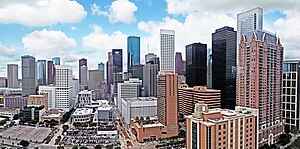Downtown Houston
| Downtown Houston | |
|---|---|
| Neighborhood of Houston | |

Skyline of Downtown
|
|
| Country |
|
| State |
|
| County | Harris County |
| City |
|
| Subdistricts of Downtown |
List
|
| Population (2010) | |
| • Total | 14,342 |
| Website | downtownhouston.org |
Downtown Houston is Houston's central business district, containing the headquarters of many prominent companies. There is an extensive network of pedestrian tunnels and skywalks connecting the buildings of the district. The tunnel system is home to many restaurants, shops and services.
What is now Downtown made up almost all of the City of Houston until expansions of the city limits in the early 20th century.
Downtown Houston was the original founding point of the city. After the Texas Revolution, two New York real estate promoters, John Kirby Allen and Augustus Chapman Allen, purchased 6,642 acres (2,688 ha) of land from Thomas F.L. Parrot and his wife, Elizabeth (John Austin's widow), for $9,428. The Allen brothers first landed in the area where the White Oak Bayou and Buffalo Bayou meet, a spot now known as Allen's Landing. Gail Borden, Jr., a city planner, laid out wide streets for the town.
The city was granted incorporation by the Texas legislature on June 5, 1837. Houston was the temporary capital of Texas. In 1840, the town was divided into four wards, each with different functions in the community. By 1906 what is now Downtown was divided among six wards. The wards are no longer political divisions, but their names are still used to refer to certain areas.
Downtown's growth can be attributed to two major factors: The first arose after the Galveston Hurricane of 1900, when investors began seeking a location close to the ports of Southwest Texas, but apparently free of the dangerous hurricanes that frequently struck Galveston and other port cities. Houston became a wise choice, as only the most powerful storms were able to reach the city. The second came a year later with the 1901 discovery of oil at spindletop, just south of Beaumont. Shipping and oil industries began flocking to east Texas, many settling in Houston. From that point forward the area grew substantially, as many skyscrapers were constructed, including the city's tallest buildings. In the 1980s, however, economic recession canceled some projects and caused others to be scaled back, such as the Bank of the Southwest Tower.
...
Wikipedia
